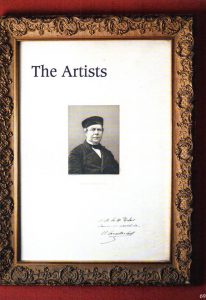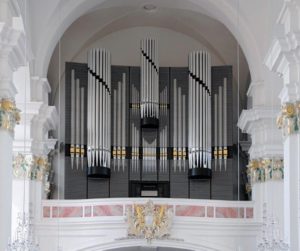Orgelkids China執行長蔣士挺(Justin Berg)「兒童管風琴教育專欄」【初因初音】。
『Aristide Cavaille-Coll』from the column【My First Sound】 by Justin Berg, the Executive Director of Orgelkids China. (In English below)
在卡發耶科爾出生之前一百多年,也就是十七世紀末,法國的管風琴建造已經達到一種成熟的風格,現在我們稱之為古典時期。這個稱呼可能會造成混淆,因為在討論音樂時,「古典」是指十八世紀後半的音樂,尤其是海頓、莫札特,還有貝多芬年輕時的作品,在此之前一百年當中的音樂通常稱為「巴洛克」。但是基於多種原因,法國此時的音樂通常稱為「古典」而不是「巴洛克」,這有一部分是因為十七和十八世紀的法國音樂已經達到一種穩定性和獨特性,因而後來發展出融合法國和義大利品味的「混合樂風」。姑且不論用甚麼名稱,這個時期的法國管風琴建造也展現出一些穩定的特點,形成獨特的樂器建造派別。為了瞭解卡發耶科爾的管風琴作品,我們就先探索古典管風琴設計的特色。
古典法國管風琴最聞名的特點應該就是簧管的音色,這些簧管的法文是anches (附圖1的紅字),意思是簧片音管,最珍貴的特點就是喧鬧的音色,由於這些音栓所呈現的感覺非常強烈,所以在古典管風琴中無法與主音管和基礎音合奏音管結合,尤其是不能與混合音栓搭配,否則會變得很難聽。基於這些簧管的威力和明亮音色,法國的管風琴建造家就詳細載明將它們的使用從個別的音栓(例如同度音高的燦爛簧片音管和古雙簧管)擴展到包含幾支小號,可能是在不同鍵盤,或在單一鍵盤內的加倍音管:有時是16呎(低八度)、8呎(同度)、4呎(高八度)音管。這種整列簧管的齊奏非常流行,到了1789年法國大革命時期,有些最大型的管風琴在好幾個鍵盤都有8呎小號和四呎法國小喇叭音管 (附圖1),並且在單一鍵盤就有第一和第二小號 (附圖1的主鍵盤)。例如,1774年在南法St. Maximin的Isnard管風琴就是這樣。在1783年,法國國王的管風琴建造廠François-Henri Clicquot重修巴黎聖母院的管風琴 (附圖2),甚至為回聲鍵盤加上8呎小號音栓和4呎法國小喇叭音栓;為了要頻繁的更換音樂性格來保證皇帝對音樂的新鮮感與注意力。
儘管如此出色,法國古樂簧管在比較高的音栓配置就會開始失去力度和飽滿,這是簧管普遍的情形。意思就是,當管風琴家彈到愈高音的鍵盤,簧管的聲音就開始變得愈微弱,這也讓我們看到古典管風琴另一個值得注意的特點:疊高的短號。為了強化簧管合奏的右手音栓組合又不使音質改變太大,這個時期的法國製琴師通常會在主鍵盤加上這組特殊的音栓。一個短號音栓通常包含五排笛狀音管,會發出不同音高的自然泛音系列,這個音栓包含了下列五種管列:同度(8呎)、高八度(4呎)、高八度加完全五度(2 2/3呎)、兩個高八度(2呎),最後則是兩個八度加一個大三度(1 3/5呎)。這些數字看起來有點怪,但是製造出的聲音卻組合成大膽又亮麗的美妙樂音,使簧管音栓的高音更飽滿有力。為了讓短號音管的聲音格外明顯,法國製琴師會把這些音管排得比主鍵盤的其他部分更高,立在高過主鍵盤其餘部分的一個小型風箱上 (附圖3),這種設計與低地國(現今的比利時和荷蘭)的管風琴相同,由於高度增加,這個音栓就擁有更威風凜凜的聲音。(待續)
你的朋友蔣士挺
〜Aristide Cavaille-Coll (part I) continued〜
By the close of the 1600s, more than a century before Aristide’s birth, French organ building had arrived at a mature style known today as its Classical period. Sometimes, this name is confusing: When talking about music, we use ‘Classical’ to refer to music of the late eighteenth century — especially the work of Haydn, Mozart and the young Beethoven. Music from 100 years earlier is typically called ‘Baroque’ but, for various reasons, music in France during that same time is often termed ‘Classical’, rather than ‘Baroque’. In part, this designation reflects the view that French music of the seventeenth and eighteenth centuries achieved a stability and uniqueness that later would contribute to the development of the so-called ‘Mixed Style’, which wedded French and Italian tastes. Regardless of the name we use, French organ building from this period also exhibited a stable set of features that identified it as a unique school of instrument building. To help us understand Cavaille-Coll’s work, we need to explore the features of Classical organ design.
Arguably the most famous characteristic of Classical French organs is the sound of their reeds. These reeds, or anches, as they are known in French, are prized for a kind of raucous quality. So fiery are these stops that, in the Classical organs, they cannot be played in combination with principal stops and choruses, especially not with mixtures — doing so just sounds ugly. Given the power and brilliance of such reeds, French organ builders expanded their use in organ specifications from individual stops (such as Trompettes and Cromornes at unison pitch) to choruses that included multiple Trompettes, either across different keyboards or duplicated within a single manual division — sometimes at 16’ (suboctave), 8’ (unison) and 4’ (superoctave) pitches. Such batteries of reeds became so popular that by the French Revolution in 1789 some of the largest organs boasted 8’ Trompette and 4’ Clairon on multiple divisions, as well as first and second Trompettes in a single division. This is the case in the 1774 Isnard organ at St. Maximin in southern France, for example. Indeed, in 1783 the King’s organ builder, François-Henri Clicquot, worked on the organ at Notre Dame, Paris, even adding 8’ Trompette and 4’ Clairon stops to the Echo division!
Despite their brilliance, and as with reeds generally, French Classical reeds begin to lose power and fullness in their higher registers. In other words, as the organist plays higher and higher toward the top of the keyboard, the reeds begin to sound thinner. And this fact brings us to another noteworthy feature of the Classical organ: the mounted Cornet. To strengthen the treble register of the reed chorus without changing the quality of their sound too much, French builders of this period routinely included this special stop on the Grand Orgue A Cornet stop is often composed of five ranks of pipes, all of them flute-like in character, but playing different pitches of the natural overtone series. Nearly always, this means a stop composed of the following five ranks: unison (8’), octave above the unison (4’), octave plus a perfect fifth above (22/3’), two octaves above (2’), and finally two octaves plus a major third above (13/5’). While all these numbers look a bit strange, the sounds they produce combine into a wonderfully bold yet beautiful tone that helps the trebles of the reed stops sound fuller and stronger. To help the Cornet sound especially pronounced, French builders placed these pipes higher than all the others on the Grand Orgue. Standing on a small windchest that was elevated above the rest of the Grand Orgue — a design feature shared with organs from the Low Countries (present-day Belgium and Holland) — this stop enjoyed a more commanding sound thanks to this added height. (To be continued.)
Your Friend,
Justin





